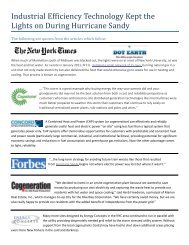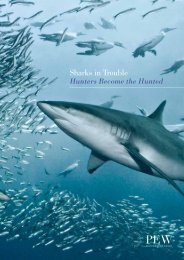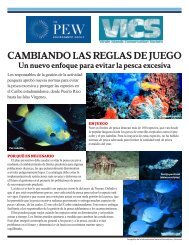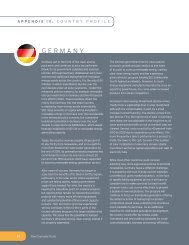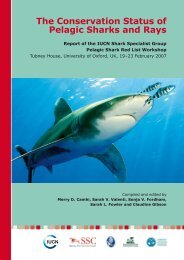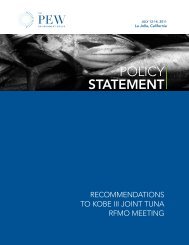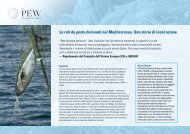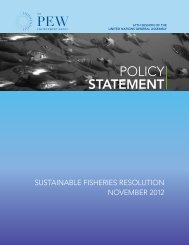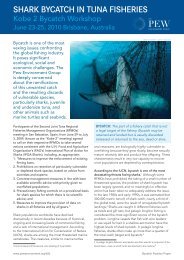The Law That's Saving American Fisheries - Ocean Conservancy
The Law That's Saving American Fisheries - Ocean Conservancy
The Law That's Saving American Fisheries - Ocean Conservancy
Create successful ePaper yourself
Turn your PDF publications into a flip-book with our unique Google optimized e-Paper software.
Endnotes<br />
1<br />
Senator Warren G. Magnuson (D-WA) told a symposium a year<br />
after passage of the act that bears his name that although U.S.<br />
landings remained relatively static from the postwar period to 1973,<br />
overall landings from <strong>American</strong> waters during that time tripled<br />
because of foreign fishing. “Foreign vessels take nearly seventy<br />
percent of the commercial catch of United States coastal fisheries,”<br />
Magnuson said. “<strong>The</strong> Fishery Conservation and Management Act of<br />
1976: First Step Toward Improved Management of Marine <strong>Fisheries</strong>,”<br />
Washington <strong>Law</strong> Review 52 (1977): 427.<br />
2<br />
Debates on the Magnuson-Stevens Act bills (S 961 and HR 200)<br />
were defined by arguments about the effect on international<br />
relations of declaring a U.S. fishery zone. <strong>The</strong> debates also included<br />
extensive remarks about optimum yield, maximum sustainable yield,<br />
and the need to restore and conserve fish populations for the future.<br />
3<br />
Ecologist P.A. Larkin, in his 1977 essay “An Epitaph for the Concept<br />
of Maximum Sustainable Yield,” called the act’s definition of<br />
optimum yield “a recipe for achieving heaven or hell, and what is<br />
achieved will depend on how the definition is variously interpreted.”<br />
Transactions of the <strong>American</strong> <strong>Fisheries</strong> Society 106, no. 1 (1977): 9.<br />
4<br />
In an article reviewing successes in fishery management,<br />
Beddington et al. cite the U.S. system as one that has found the<br />
right combination of rules and incentives to halt overfishing and<br />
accomplish rebuilding. J.R. Beddington et al., “Current Problems in<br />
the Management of <strong>Fisheries</strong>,” Science 316, no. 5832 (2007): 1713-1716.<br />
See also R. Hilborn, “Reinterpreting the State of <strong>Fisheries</strong> and their<br />
Management,” Ecosystems 10, no. 8 (2007): 1362-1369.<br />
5<br />
<strong>The</strong> pollock and whiting fisheries of the Pacific produce more<br />
kinds of products and more pounds of seafood products per 100<br />
pounds of fish caught: 37 in 2012 compared with 19.5 in 1998. Jim<br />
Gilmore, pers. comm., March 4, 2013, report on Product Recovery Mix<br />
2012, Sea State Inc.<br />
6<br />
National <strong>Ocean</strong>ic and Atmospheric Administration <strong>Fisheries</strong>,<br />
“<strong>Fisheries</strong> Economics of the United States, 2009,” Economics<br />
and Sociocultural Status and Trends Series, NOAA Technical<br />
Memorandum NMFS-F/SPO-118, May 2011.<br />
7<br />
Ibid.<br />
8<br />
<strong>Ocean</strong>s ’78 Conference, September 1978, Washington, DC.<br />
9<br />
Magnuson-Stevens Fishery Conservation and Management Act,<br />
Public <strong>Law</strong> 94-265 (1976) as amended by Public <strong>Law</strong> 109-479 (2006), 16<br />
U.S.C. 1801 et seq.<br />
10<br />
“<strong>The</strong> main thrust of the legislation is to provide a mechanism<br />
and program of conservation and management in order to save<br />
and revitalize the valuable fishery resources adjacent to our shores.<br />
Time was running out on many vital stocks. This was clear to anyone<br />
who understood the situation.” Warren G. Magnuson, “<strong>The</strong> Fishery<br />
Conservation and Management Act of 1976: First Step Toward<br />
Improved Management of Marine <strong>Fisheries</strong>,” Washington <strong>Law</strong> Review<br />
52 (1977): 427.<br />
11<br />
Sustainable <strong>Fisheries</strong> Act, Public <strong>Law</strong> 104-297 (1996).<br />
12<br />
U.S. Commission on <strong>Ocean</strong> Policy, An <strong>Ocean</strong> Blueprint for the<br />
21st Century, final report (2004), and the Pew <strong>Ocean</strong>s Commission,<br />
America’s Living <strong>Ocean</strong>s: Charting a Course for Sea Change (2003).<br />
13<br />
Senate Report 109-229 on S 2012 (April 4, 2006), 21.<br />
14<br />
Thomas. F. Ihde et al., “<strong>The</strong> increasing importance of marine<br />
recreational fishing in the US: challenges for management,” <strong>Fisheries</strong><br />
Research 108 (2011), 268.<br />
15<br />
Senator Ted Stevens (AK), opening statement, field hearing<br />
(Boston) on reauthorization of the Magnuson-Stevens Act,<br />
Subcommittee on <strong>Ocean</strong>s and <strong>Fisheries</strong>, Senate Committee on<br />
Commerce, Science and Transportation, April 10, 2000.<br />
16<br />
Stock assessment report for South Atlantic black sea bass,<br />
Southeast Data, Assessment, and Review 25, Section 1, October 2011.<br />
Improvement in landings, biomass, fishing mortality, and spawning<br />
potential ratio are calculated from data in Tables 5.2a, Table 5.3, and<br />
Fig. 4.12.1.<br />
17<br />
Ibid.<br />
18<br />
George J. Geiger, testimony on “NOAA’s Fishery Science: Is the<br />
Lack of Basic Science Costing Jobs?,” Subcommittee on <strong>Fisheries</strong>,<br />
Wildlife, <strong>Ocean</strong>s, and Insular Affairs, U.S. House Committee on<br />
Natural Resources, July 26, 2011, http://www.gpo.gov/fdsys/pkg/<br />
CHRG-112hhrg67648/pdf/CHRG-112hhrg67648.pdf.<br />
19<br />
Final Rule to Amend National Standard Guidelines to Provide<br />
Guidance on Annual Catch Limits. 74 Federal Register 3178 (Jan. 16,<br />
2009). NOAA <strong>Fisheries</strong> published a notice of intent to further clarify<br />
NS1 guidance May 3, 2012.<br />
20<br />
S. A. Murawski, “Rebuilding Depleted Fish Stocks: <strong>The</strong> Good,<br />
the Bad, and, Mostly, the Ugly,” ICES Journal of Marine Science 67<br />
(2010):1830–1840.<br />
21<br />
NOAA, 2011 Status of Stocks report press release, http://www.<br />
nmfs.noaa.gov/stories/2012/05/05_14_12status_of_stocks_rollout.<br />
html.<br />
22<br />
S.A. Murawski, “Rebuilding Depleted Fish Stocks.”<br />
23<br />
Pers. comm., Mid-Atlantic Fishery Management Council,<br />
September 7, 2012.<br />
24<br />
J.M. Gates, “Investing in Our Future: <strong>The</strong> Economic Case for<br />
Rebuilding Mid-Atlantic Fish Populations” (2009), published by the<br />
Pew Environment Group, Washington, DC, http://www.pewtrusts.<br />
org/uploadedFiles/wwwpewtrustsorg/Reports/Protecting_ocean_<br />
life/final%20PEG_Rebuilding%20072209.pdf.<br />
25<br />
Mid-Atlantic Fishery Management Council, Summer Flounder<br />
Monitoring Committee recommendation, 2011.<br />
26<br />
J.M. Gates, “Investing in Our Future.”<br />
27<br />
In its report on the program’s first year, NOAA <strong>Fisheries</strong> found that<br />
revenue climbed to $54 million in 2011 compared with the pre-catch<br />
share average of $38 million from 2006 to 2010. NOAA <strong>Fisheries</strong>,<br />
“Year One: West Coast Groundfish IFQ Fishery,” June 2012.<br />
28<br />
National Research Council, Science and Its Role in the National<br />
Marine <strong>Fisheries</strong> Service (National Academies Press, 2002), 3.<br />
29<br />
Eric Schwaab, testimony on NOAA’s fishery science, House<br />
Natural Resources Subcommittee on <strong>Fisheries</strong>, Wildlife, <strong>Ocean</strong>s and<br />
Insular Affairs, July 26, 2011, http://www.commerce.gov/os/ogc/<br />
testimony/noaas-fishery-science-lack-basic-science-costing-jobs.<br />
30<br />
C. Mora et al., “Management Effectiveness of the World’s Marine<br />
<strong>Fisheries</strong>,” PLoS Biology 7 (2009).<br />
31<br />
Examples include reforms to the Common <strong>Fisheries</strong> Policy being<br />
considered by the European Union.<br />
32<br />
NOAA, Northeast <strong>Fisheries</strong> Science Center press release, August<br />
2009, http://www.nefsc.noaa.gov/press_release/2009/News/<br />
NR0911/index.html.<br />
38 It’s a Keeper



